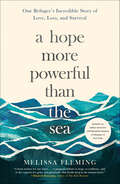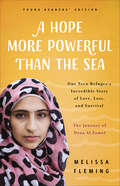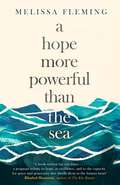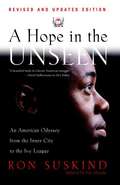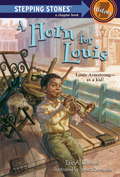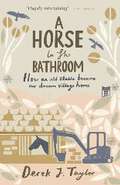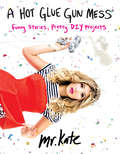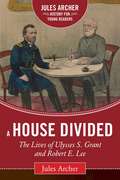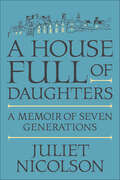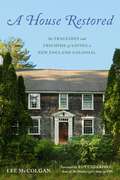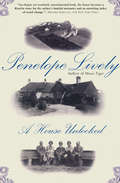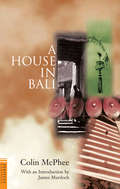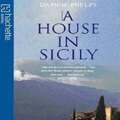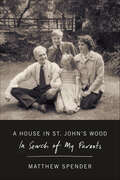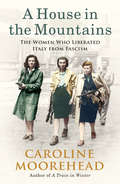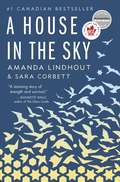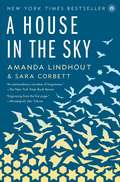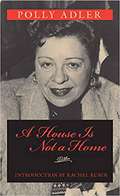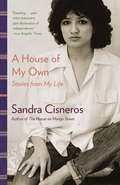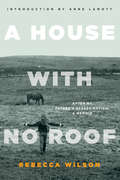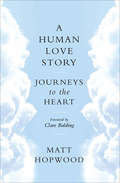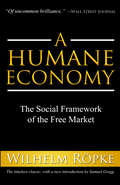- Table View
- List View
A Hope More Powerful Than the Sea: One Refugee's Incredible Story of Love, Loss, and Survival
by Melissa FlemingThe gripping story of a young woman who fled civil war in Syria and endured a harrowing journey across the Mediterranean for a chance of a better life.Adrift in a frigid sea, no land in sight, just debris from the ship’s wreckage and floating corpses all around, nineteen-year-old Doaa Al Zamel stays afloat on a small inflatable ring and clutches two little girls—barely toddlers—to her body. The children had been thrust into Doaa’s arms by their drowning relatives, all refugees who boarded a dangerously overcrowded ship bound for Italy and a new life. For days as Doaa drifts, she prays for rescue and sings to the babies in her arms. She must stay alive for them. She must not lose hope.A Hope More Powerful Than the Sea chronicles the life of Doaa, a Syrian girl whose life was upended in 2011 by the onset of her country’s brutal civil war. Doaa and her fiancé, Bassem, decide to flee to Europe to seek safety and an education, but four days after setting sail on a smuggler’s dilapidated fishing vessel along with five hundred other refugees, their boat is struck and begins to sink. This is the moment when Doaa’s struggle for survival really begins.This emotionally charged, eye-opening true story that represents the millions of unheard voices of refugees who risk everything in a desperate search for the promise of a safe future. In the midst of the most pressing international humanitarian crisis of our time, Melissa Fleming paints a vivid, unforgettable portrait of the triumph of the human spirit.“Urgently required reading.” —People“Deeply affecting . . . Fleming brings a moral urgency to the narrative.” —The New Yorker“Fleming deftly illustrates the pain of those who choose to leave Syria . . . and her book is ultimately a story of hope.” —Newsweek
A Hope More Powerful Than the Sea: The Journey of Doaa Al Zamel
by Melissa FlemingThe extraordinary true story of one teen refugee’s quest to find a new life—now adapted for young readersA Hope More Powerful Than the Sea tells the story of Doaa Al-Zamel, a Syrian girl whose life was upended in 2011 by her country’s brutal civil war. She and her family escape to Egypt, but life soon quickly becomes dangerous for Syrians in that country. Doaa and her fiancé decide to flee to Europe to seek safety and an education, but four days after setting sail on a smuggler’s dilapidated fishing vessel along with five hundred other refugees, their boat is struck and begins to sink...Doaa’s eye-opening story, as told by Melissa Fleming, represents the millions of unheard voices of refugees who risk everything in a desperate search for a safe future.
A Hope More Powerful than the Sea
by Melissa FlemingSoon to be a major film, produced by Steven Spielberg and J. J. Abrams.This is the story of Doaa, an ordinary girl from a village in Syria, who in 2015 became one of five hundred people crammed on to a fishing boat setting sail for Europe. The boat was deliberately capsized, and of those five hundred people, eleven survived; they were rescued four days after the boat sank. Doaa was one of them - her fiancé Bassem, with whom she had fled, was not; he drowned in front of her. Melissa Fleming, the Chief Spokesperson for the UN High Commissioner for Refugees, heard about Doaa and the death of 489 of her fellow refugees on the day she was pulled out of the water. She decided to fly to Crete to meet this extraordinary girl, who had rescued a toddler when she was nearly dead herself. They struck an instant bond, and Melissa saw in Doaa the story of the war in Syria embodied by one young woman. She has decided to tell Doaa's story - the dangers she fled, and the journey she risked to escape the conflagration in her homeland. Doaa is the face of the millions of mothers, fathers, sisters, brothers, daughters and sons who risk everything as they try to escape war, violence and death. Doaa's story will revolutionize how we see the thousands of people who die every year in search of a home. It will squarely face one of the greatest moral questions of our age: will we let more people die in boats and trucks, or will we find a way to help them?
A Hope in the Unseen: An American Odyssey from the Inner City to the Ivy League
by Ron SuskindAs an honor student walking the gauntlet of sneers and threats at his crime-infested high school in Washington, D. C. , Cedric Jennings achieved the impossible: a 4. 02 grade-point average and acceptance into Brown University. Suskind won a Pulitzer Prize in 1995 for his stories about Jennings and now expands them into this full-length, nonfiction narrative. Copyright © Libri GmbH. All rights reserved.
A Horn For Louis
by Eric A. KimmelSeven-year-old Louis Armstrong was too poor to buy a real horn. He didn’t even go to school. To help his mother pay the rent, Louis had a job. Every day he rode a junk wagon through the streets of New Orleans, playing his tin horn and collecting stuff people didn’t want. Then one day the junk wagon passed a pawn shop with a gleaming brass trumpet in the window. . . . A Horn for Louisis perfect for Black History Month. With messages about hard work, persistence, hope, tolerance, cooperation, trust, and friendship, it’s perfect for the rest of the year, too! From the Hardcover edition.
A Horse in the Bathroom: How an Old Stable Became Our Dream Village Home
by Derek J. TaylorWhen Derek and Maggie decide to escape to the country, they set about converting an old Cotswold stables into their dream home. Over the next two years, they wage guerrilla war on the Planning Office, are cursed by collapsing walls and poison gas, run out of money, and meet some very strange characters.
A Horse in the Bathroom: How an Old Stable Became Our Dream Village Home
by Derek J. TaylorWhen Derek and Maggie decide to escape to the country, they set about converting an old Cotswold stables into their dream home. Over the next two years, they wage guerrilla war on the Planning Office, are cursed by collapsing walls and poison gas, run out of money, and meet some very strange characters.
A Hot Glue Gun Mess
by Mr KateFrom the offbeat blogger and designer Kate Albrecht--a.k.a. Mr. Kate--comes a not-so- average DIY lifestyle book.Her love of self-expression and her desire to live an anything-but-normal life outside of the box inspired Mr. Kate to create her own unique DIY life. Her projects involve style, home design, and beauty--including DIY nail art and makeup techniques, up-cycled projects to revive tired items in your wardrobe, and stunning home-decor touches to beautify your living space. You don't have to be a seamstress, a metalsmith, or an expert at anything to enjoy these projects, all of which are doable in under two hours and require just a few easy-to-find supplies. Now you, too, can become a DIY diva!l, inspiring, and downright hilarious.Her love of self-expression inspired Mr. Kate to create her own DIY life and a social media platform to connect with young women everywhere. Her projects involve style, home design, and beauty, including DIY nail art techniques, upcycled projects for your old jeans , and watercolor curtains. You don't have to be a seamstress, metalsmith, or expert at anything to enjoy these projects, all of which are doable in under two hours and require a minimal number of supplies. Now you, too, can become a DIY diva!
A House Divided: The Lives of Ulysses S. Grant and Robert E. Lee (Jules Archer History for Young Readers)
by Jules ArcherA House Divided is an exciting introduction to two of the most fascinating players in the American Civil War. Ulysses S. Grant was gruff and sloppy, the son of a hardworking but uneducated man opposed to slavery. Robert E. Lee, a slave owner himself, was a polite, aristocratic Virginia gentleman who descended from the Revolutionary War hero "Light-Horse Harry. ” Both men studied at West Point but developed very different tactics--Lee proved to be a careful strategist who made brilliant use of standard military tactics, while Grant was instinctive, spontaneous, and unconventional. Pitted against one another, the two became the most influential players in the bloodiest and most wrenching episode of American history. In alternating chapters, historian Jules Archer begins by exploring their formative years and early careers all the way through their postwar lives. Archer focuses on the men’s roles during the Civil War, detailing down to specific battles and decisions made by each man. Perfect for reluctant young historians as well as history-buffs-to-be. Part of the Jules Archer History for Young Readers series by Sky Pony Press, this book is guaranteed to inspire interest in a crucial piece of American history
A House Full of Daughters: A Memoir of Seven Generations
by Juliet NicolsonA family memoir that traces the myths, legends, and secrets of seven generations of remarkable womenAll families have their myths and legends. For many years Juliet Nicolson accepted hers--the dangerous beauty of her flamenco dancing great-great-grandmother Pepita, the flirty manipulation of her great-grandmother Victoria, the infamous eccentricity of her grandmother Vita Sackville-West, her mother’s Tory-conventional background. But then Juliet, a distinguished historian, started to question. As she did so, she sifted fact from fiction, uncovering details and secrets long held just out of sight. A House Full of Daughters takes us through seven generations of women. In the nineteenth-century slums of Malaga, the salons of fin-de-siecle Washington D.C., an English boarding school during the Second World War, Chelsea in the 1960s, the knife-edge that was New York City in the 1980s, these women emerge for Juliet as people in their own right, but also as part of who she is and where she has come from. A House Full of Daughters is one woman’s investigation into the nature of family, memory, and the past. As Juliet finds uncomfortable patterns reflected in these distant and more recent versions of herself, she realizes her challenge is to embrace the good and reject the hazards that have trapped past generations.
A House Restored: The Tragedies and Triumphs of Saving a New England Colonial
by Lee McColganShop Class as Soulcraft meets A Place of My Own in this lyrical meditation of a woodworker steadfastly repairing a historic home. Old houses share their secrets only if they survive. Trading the corporate ladder for a stepladder, Lee McColgan commits to preserving the ramshackle Loring House, built in 1702, using period materials and methods and on a holiday deadline. But his enchantment withers as he discovers the massive repairs it needs. A small kitchen fix reveals that the structure’s rotten frame could collapse at any moment. In a bathroom, mold appears and spreads. He fights deteriorating bricks, frozen pipes, shattered windows, a punctured foundation, and even an airborne chimney cap while learning from a diverse cast of preservationists, including a master mason named Irons, a stone whisperer, and the Window Witch. But can he meet his deadline before family and friends arrive, or will it all come crashing down? McColgan’s journey expertly examines our relationship to history through the homes we inhabit, beautifully articulating the philosophy of preserving the past to find purpose for the future.
A House Unlocked (Isis Series)
by Penelope LivelyThis “interesting and perceptive” memoir recalls the familial country house the author’s grandparents bought in 1923 (The Washington Post Book World). The only child of divorced parents, Penelope Lively was often sent to stay at her grandparents’ country house, Golsoncott. Long after the house was sold out of the family, she begins to piece together the lives of those she knew fifty years before. As her narrative shifts from room to room, object to object, Lively paints a moving portrait of an era of rapid change—and of a family that transformed with the times. Charting the course of the domestic tensions of class and community among her relatives, she brings to light the evidence of the horrors endured during the Russian Revolution and the Holocaust through accounts of the refugees who came to live with them. “An elegiac yet resolutely unsentimental book, the house becomes a Rosetta stone for the author’s familial memories and an unwitting index of social change” in this eloquent meditation on place and time, memory and history, and tribute to the meaning of home (Michiko Kakutani, The New York Times).
A House in Bali
by Colin McpheeThis is a book about passion, obsession and discovery in an amazing land, but also about the voyage of a highly talented composer and writer. A House in Bali remains one of the most remarkable books ever written about the fabled island of Bali. This classic book tells the story of Balinese culture through a history of Balinese music. First published in 1947, it tells the story of the writer and composer Colin McPhee's (1900–64) obsession with a music once unknown to the West, and of his journey to Bali to experience it firsthand. In 1929, the young Canadian– born musician chanced upon rare gramophone recordings of Balinese gamelan music which were to change his life forever. From that moment, he lived for the day when he could set foot on the island where the clear, metallic music originated. He was able to realize his dreams and spent almost a decade there during the 1930's. Music of Bali and dance, as McPhee discovered to his delight, are second nature to the Balinese, and his subsequent writings and compositions proved seminal in popularizing Balinese gamelan music in the West. InA House in Bali, McPhee unfolds a beguiling picture of a society long established, staggeringly poor in Western terms, but rich beyond belief in spiritual values and joy. The young composer writes about his discoveries of music in Bali and growing understanding of an astonishing culture where the arts are a prime preoccupation, and of the arts, music is supreme. Much has been written on Bali, but this classic work from 1947 remains the only narrative by a Western musician.
A House in Sicily
by Daphne PhelpsNear Mount Etna in Sicily lies Casa Cuseni, a beautiful house built in golden stone - and the home which Daphne Phelps was astonished to find she had inherited in 1947. At the age of 34, war-weary from working as a psychiatric social worker, with barely any Italian, and precious little money, she plunged into a fascinating Sicilian world. Every imaginable problem had to be overcome, not only financial difficulties but local authorities and a house staff who initially felt no loyalty to the new Signorina but who gradually accepted her as a respected member of their small community. To help make ends meet, for many years she ran Casa Cuseni as a pensione and to her doors came Roald Dahl, Tennessee Williams, Bertrand Russell and Henry Faulkner. But just as important to her life and her story are the Sicilians with whom she shared the love and care of Casa Cuseni: Don Ciccio the local mafia leader, Vincenzio, general manservant who recited while he served the meals, Beppe, a Don Juan who scented his eyebrows and his moustache to attract the local girls; and above all the steadfast cook and housekeeper who lives with Daphne still and to whom this book is dedicated.
A House in St. John's Wood: In Search of My Parents
by Matthew SpenderA son's personal exploration of one of the most influential—and troubled—artistic couples of the twentieth centuryStephen Spender's life, with all its secrets, successes, and contradictions, is a vivid prism through which to view the twentieth century. He befriended Auden and Isherwood while at Oxford, and together the three had wildly transgressive adventures in Europe and were early vocal critics of Hitler and the rise of fascism in their celebrated writings. Like his friends, Spender was drawn to other men, yet he eventually married Natasha, a world-renowned concert pianist, and started a family. In the midst of a heady world of poetry and liberal politics, gay love affairs and tense silences, Matthew Spender grew up the child of two brilliant artists. Taught how to use adjectives by Uncle Auden and raised among the British cultural elite, Matthew led what might have been a charmed existence were it not for the tensions in his own household. His father, always susceptible to the allure of young men, was unable to stop himself, or reveal his secret, for the sake of his family; and his mother's suffering led her to infatuations of her own. Stephen Spender: In Search of My Father is a son's attempt to reconstruct a portrait of his magnetic father and unconventional family out of the ambiguous experiences of his childhood. Drawing on unpublished letters and diaries, family keepsakes and youthful memories, Matthew Spender tells the story of a singular family in the midst of its own cold war, as the artistic world of mid-century London circled around them.
A House in the Mountains: The Women Who Liberated Italy from Fascism (The\resistance Quartet Ser. #4)
by Caroline MooreheadThe extraordinary story of four courageous women who helped form the Italian Resistance against the Nazis and the Fascists during the Second World War.In the late summer of 1943, when Italy changed sides in WWII and the Germans, now their enemies, occupied the north of the country, an Italian Resistance was born. Ada, Frida, Silvia and Bianca were four young Piedmontese women who joined the Resistance, living secretively in the mountains surrounding Turin. They were not alone. Between 1943 and 1945, as the Allies battled their way north, thousands of men and women throughout occupied Italy rose up and fought to liberate their country from the German invaders and their Fascist collaborators. What made the partisan war all the more extraordinary was the number of women in its ranks. The bloody civil war that ensued across the country pitted neighbour against neighbour, and brought out the best and worst in Italian society. The courage shown by the partisans was exemplary, and eventually bound them together as a coherent fighting force. And the women's contribution was invaluable--they fought, carried messages and weapons, provided safe houses, laid mines and took prisoners. Ada's house deep in the mountains became a meeting place and refuge for many of them. The death rattle of Mussolini's two decades of Fascist rule--with its corruption, greed and anti-Semitism--was unrelentingly violent and brutal, but for the partisan women it was also a time of camaraderie and equality, pride and optimism. They would prove, to themselves and to the world, what resolve, tenacity and above all exceptional courage could achieve.
A House in the Sky
by Sara Corbett Amanda LindhoutThe spectacularly dramatic memoir of a woman whose curiosity about the world led her from rural Canada to imperiled and dangerous countries on every continent, and then into fifteen months of harrowing captivity in Somalia--a story of courage, resilience, and extraordinary grace.At the age of eighteen, Amanda Lindhout moved from her hardscrabble Alberta hometown to the big city--Calgary--and worked as a cocktail waitress, saving her tips so she could travel the globe. As a child, she escaped a violent household by paging through National Geographic and imagining herself in its exotic locales. Now she would see those places for real. She backpacked through Latin America, Laos, Bangladesh, and India, and emboldened by each experience, went on to travel solo across Sudan, Syria, and Pakistan. In war-ridden Afghanistan and Iraq she carved out a fledgling career as a TV reporter. And then, in August 2008, she traveled to Mogadishu, Somalia--"the most dangerous place on earth"--to report on the fighting there. On her fourth day in the country, she and photojournalist Nigel Brennan were abducted by a group of masked men along a dusty road. An astoundingly intimate and harrowing account of Lindhout's fifteen months as a captive, A House in the Sky illuminates the psychology, motivations, and desperate extremism of her young guards and the men in charge of them. She is kept in chains, nearly starved, and subjected to unthinkable abuse. She survives by imagining herself in a "house in the sky," looking down at the woman shackled below, and finding strength and hope in the power of her own mind. Lindhout's decision, upon her release, to counter the violence she endured by founding an organization to help the Somali people rebuild their country through education is a wrenching testament to the capacity of the human spirit and an astonishing portrait of the power of compassion and forgiveness.
A House in the Sky
by Sara Corbett Amanda LindhoutBREAKING NEWS: Amanda Lindhout's lead kidnapper, Ali Omar Ader, has been caught. Amanda Lindhout wrote about her fifteen month abduction in Somalia in A House in the Sky. It is the New York Times bestselling memoir of a woman whose curiosity led her to the world's most remote places and then into captivity: "Exquisitely told...A young woman's harrowing coming-of-age story and an extraordinary narrative of forgiveness and spiritual triumph" (The New York Times Book Review).As a child, Amanda Lindhout escaped a violent household by paging through issues of National Geographic and imagining herself visiting its exotic locales. At the age of nineteen, working as a cocktail waitress, she began saving her tips so she could travel the globe. Aspiring to understand the world and live a significant life, she backpacked through Latin America, Laos, Bangladesh, and India, and emboldened by each adventure, went on to Sudan, Syria, and Pakistan. In war-ridden Afghanistan and Iraq she carved out a fledgling career as a television reporter. And then, in August 2008, she traveled to Somalia--"the most dangerous place on earth." On her fourth day, she was abducted by a group of masked men along a dusty road. Held hostage for 460 days, Amanda survives on memory--every lush detail of the world she experienced in her life before captivity--and on strategy, fortitude, and hope. When she is most desperate, she visits a house in the sky, high above the woman kept in chains, in the dark. Vivid and suspenseful, as artfully written as the finest novel, A House in the Sky is "a searingly unsentimental account. Ultimately it is compassion--for her naïve younger self, for her kidnappers--that becomes the key to Lindhout's survival" (O, The Oprah Magazine).
A House in the Sky: A Memoir
by Sara Corbett Amanda LindhoutBREAKING NEWS: Amanda Lindhout's lead kidnapper, Ali Omar Ader, has been caught. Amanda Lindhout wrote about her fifteen month abduction in Somalia in A House in the Sky. It is the New York Times bestselling memoir of a woman whose curiosity led her to the world's most remote places and then into captivity: "Exquisitely told...A young woman's harrowing coming-of-age story and an extraordinary narrative of forgiveness and spiritual triumph" (The New York Times Book Review).As a child, Amanda Lindhout escaped a violent household by paging through issues of National Geographic and imagining herself visiting its exotic locales. At the age of nineteen, working as a cocktail waitress, she began saving her tips so she could travel the globe. Aspiring to understand the world and live a significant life, she backpacked through Latin America, Laos, Bangladesh, and India, and emboldened by each adventure, went on to Sudan, Syria, and Pakistan. In war-ridden Afghanistan and Iraq she carved out a fledgling career as a television reporter. And then, in August 2008, she traveled to Somalia--"the most dangerous place on earth." On her fourth day, she was abducted by a group of masked men along a dusty road. Held hostage for 460 days, Amanda survives on memory--every lush detail of the world she experienced in her life before captivity--and on strategy, fortitude, and hope. When she is most desperate, she visits a house in the sky, high above the woman kept in chains, in the dark. Vivid and suspenseful, as artfully written as the finest novel, A House in the Sky is "a searingly unsentimental account. Ultimately it is compassion--for her naïve younger self, for her kidnappers--that becomes the key to Lindhout's survival" (O, The Oprah Magazine).
A House is Not a Home
by Rachel Rubin Polly AdlerPolly Adler's "house"―the brothel that gave this best-selling 1953 autobiography its title―was a major site of New York City underworld activity from the 1920s through the 1940s. Adler's notorious Lexington Avenue house of prostitution functioned as a sort of social club for New York's gangsters and a variety of other celebrities, including Robert Benchley and his friend Dorothy Parker. According to one New York tabloid, it made Adler's name "synonymous with sin." <P><P> This new edition of Adler's autobiography brings back into print a book that was a mass phenomenon, in both hardback and paperback, when it was first published. A self-consciously literary work, A House Is Not a Home provides an informal social history of immigrant mobility, prostitution, Jewish life in New York, police dishonesty, the "white slavery" scare of the early twentieth century, and political corruption. <P><P> Adler's story fills an important gap in the history of immigrant life, urban experience, and organized crime in New York City. While most other accounts of the New York underworld focus on the lives of men, from Herbert Asbury's Gangs of New York through more recent works on Jewish and Italian gangsters, this book brings women's lives and problems to the forefront. <P><P> A House Is Not a Home is compellingly readable and was popular enough to draw Hollywood's attention in the early 1960s―leading to a film starring Shelley Winters as Adler. The book has been largely forgotten in the ensuing decades, lost both to its initial audience of general readers and to scholars in women's studies, immigration history, and autobiography who are likely to find it a treasure trove. Now, with a new introduction by Rachel Rubin that contextualizes Adler's life and literary achievement, A House Is Not a Home is again available to the many readers who have come to understand such "marginal" life stories as a special refraction of the more typical American success narrative.
A House of My Own
by Sandra CisnerosFrom the author of The House on Mango Street, a richly illustrated compilation of true stories and nonfiction pieces that, taken together, form a jigsaw autobiography--an intimate album of a beloved literary legend. From the Chicago neighborhoods where she grew up and set her groundbreaking The House on Mango Street to her abode in Mexico in a region where "my ancestors lived for centuries," the places Sandra Cisneros has lived have provided inspiration for her now-classic works of fiction and poetry. But a house of her own, where she could truly take root, has eluded her. With this collection--spanning three decades, and including never-before-published work--Cisneros has come home at last. Ranging from the private (her parents' loving and tempestuous marriage) to the political (a rallying cry for one woman's liberty in Sarajevo) to the literary (a tribute to Marguerite Duras), and written with her trademark lyricism, these signature pieces recall transformative memories as well as reveal her defining artistic and intellectual influences. Poignant, honest, deeply moving, this is an exuberant celebration of a life in writing lived to the fullest.From the Hardcover edition.
A House of My Own: Stories from My Life
by Sandra CisnerosFrom the author of The House on Mango Street, a richly illustrated compilation of true stories and nonfiction pieces that, taken together, form a jigsaw autobiography--an intimate album of a beloved literary legend. From the Chicago neighborhoods where she grew up and set her groundbreaking The House on Mango Street to her abode in Mexico in a region where "my ancestors lived for centuries," the places Sandra Cisneros has lived have provided inspiration for her now-classic works of fiction and poetry. But a house of her own, where she could truly take root, has eluded her. With this collection--spanning three decades, and including never-before-published work--Cisneros has come home at last. Ranging from the private (her parents' loving and tempestuous marriage) to the political (a rallying cry for one woman's liberty in Sarajevo) to the literary (a tribute to Marguerite Duras), and written with her trademark lyricism, these signature pieces recall transformative memories as well as reveal her defining artistic and intellectual influences. Poignant, honest, deeply moving, this is an exuberant celebration of a life in writing lived to the fullest.From the Hardcover edition.
A House with No Roof: After My Father's Assassination, A Memoir
by Rebecca WilsonIn 1966, Rebecca Wilson's father, a Union Leader and civil rights activist, was assassinated on the street in San Francisco. Rebecca—known throughout as "Becky"—was three years old. A House with No Roof is Wilson's gripping memoir of how the murder of her father propelled her family into a life–long search for solace and understanding.Following her father's death, Becky's mother, Barbara, desperate for closure and peace, uproots the family and moves to Bolinas, California. In this small, coastal town of hippies, artists, and "burnouts," the family continues to unravel. To cope, Barbara turns to art and hangs a banner that loudly declares, "Wilsons are Bold." But she still succumbs to her grief, neglecting her children in her wake. Becky's brother turns to drugs while her beautiful sister chooses a life on the road and becomes pregnant. As Becky fumbles and hurtles toward adulthood herself, she comes to learn the full truth of her father's death—a truth that threatens to steal her sanity and break her spirit.Told with humor and candor—and with love and family devotion at its heart—A House with No Roof is a brave account of one daughter's struggle to survive.
A Human Love Story: Journeys to the Heart (Human Love Stories Ser.)
by Matt Hopwood&“An archive of real-life stories about all aspects of human relationships&” curated by a man traveling on foot throughout Scotland (BBC Arts). Matt Hopwood set off with just a small bag and a walking stick, no possessions and an open mind to walk many hundreds of miles the length and breadth of the country. He relied entirely on the generosity of strangers for shelter and asked people to tell him their transforming stories. They did. All of these deeply enthralling, profoundly honest stories weave a web of tenderness, connection, compassion and community. For some people their love story will span decades and tell a tale of romantic love evolving through the passing years. Others&’ stories express fleeting moments of connection, care, concern. Most love stories are marked by sadness and loss. Some stories are concerned with maternal and paternal love, others with a love of place, a visceral connection with spirit through landscape. Love stories also connect deeply with our identities, in how we belong and how we are welcomed in society. Each story is different. Each beautiful. Each valuable.&“A delicately woven tapestry of human life, collected by a stranger who offered an ear to listen without judgment and who has the depth of soul to interpret the complicated layers of love.&” —from the foreword by Clare Balding&“This thoughtfully presented lexicon of love contains honest accounts from men and women of all ages and offers an antidote to a life where it can be surprisingly hard to say &‘I love you.&’&”—The Wee Review
A Humane Economy: The Social Framework of the Free Market
by Wilhelm Röpke&“A Humane Economy is like a seminar on integral freedom conducted by a professor of uncommon brilliance.&” —Wall Street Journal&“If any person in our contemporary world is entitled to a hearing it is Wilhelm Röpke.&” —New York TimesA Humane Economy offers one of the most accessible and compelling explanations of how economies operate ever written. The masterwork of the great twentieth-century economist Wilhelm Röpke, this book presents a sweeping, brilliant exposition of market mechanics and moral philosophy.Röpke cuts through the jargon and statistics that make most economic writing so obscure and confusing. Over and over, the great Swiss economist stresses one simple point: you cannot separate economic principles from human behavior.Röpke&’s observations are as relevant today as when they were first set forth a half century ago. He clearly demonstrates how those societies that have embraced free-market principles have achieved phenomenal economic success—and how those that cling to theories of economic centralization endure stagnation and persistent poverty.A Humane Economy shows how economic processes and government policies influence our behavior and choices—to the betterment or detriment of life in those vital and highly fragile human structures we call communities. &“It is the precept of ethical and humane behavior, no less than of political wisdom,&” Röpke reminds us, &“to adapt economic policy to man, not man to economic policy.&”
